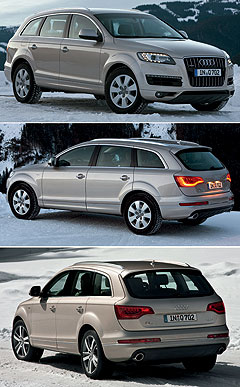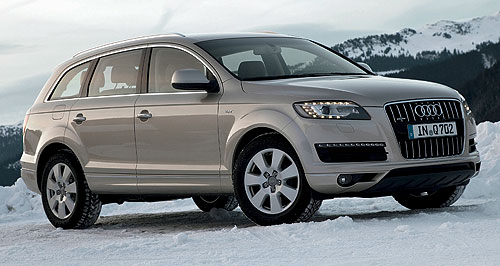Future models - Audi - Q7First look: Audi re-engines Q7Lucky 7: Audi's Q7 gets a brace of new engines and transmissions in its mid-life revamp. V8-replacing supercharged V6 and eight-speed auto for Audi’s upgraded Q712 Apr 2010 AUDI has borrowed a range of technologies from the all-new 2010 Volkswagen Touareg and Porsche Cayenne for its midlife makeover of the full-size Q7 wagon originally launched here in September 2006. Biggest news is a pair of supercharged 3.0-litre V6s to replace the 4.2-litre petrol V8 in the revised Q7 line-up and, while Audi Australia has confirmed the 2010 Q7 will go on sale here late this year, neither blown V6 is confirmed for Australia. Matching and bettering both German SUV models as well as BMW’s facelifted X5, the upgraded Q7 – announced on the same day that Audi revealed facelifted TT and A3 models – comes with an eight-speed automatic transmission as standard, plus a regenerative braking system. Replacing the current model’s six-speed automatic on all but the flagship Q7 V12 TDI, whose carryover 368kW/1000Nm 6.0-litre turbo-diesel engine continues to make it “the most powerful diesel SUV in the world”, Audi says its new Tiptronic transmission reduces fuel consumption by about five per cent. Equally significant are a second-generation 3.0-litre diesel V6 and two new supercharged 3.0-litre ’TFSI’ petrol V6s to replace the current Q7 3.6 FSI and 4.2 FSI V8. That means that while all 2011 Q7 engines feature forced induction and direct-injection, the only V8 will be diesel-powered in the Q7 4.2 TDI quattro. Also seen in the facelifted A6 and the latest S4 – as well as Porsche’s upcoming Cayenne S Hybrid – Audi’s new blown 90-degree V6 appears in two states of tunes in the Q7 for the first time: the familiar 245kW/440Nm version and a new entry-level version that develops 200kW and 400Nm of torque between 2250 and 4750rpm. The pre-existing 3.0 TFSI delivers maximum torque between 2900 and 5300rpm. “Vigorous thrust and spontaneous throttle response make the 3.0 TFSI engine, with its sonorous note, an ideal source of power for the large high-performance SUV from Audi,” says the company of its supercharged V6 engines, both of which are fitted with twin intercoolers.  The low-blow Q7 3.0 TFSI is claimed to sprint to 100km/h in 7.9 seconds on its way to a 222km/h top speed (225km/h with optional air suspension), while both engines return average fuel consumption of 10.7L/100km, making the 1.4L/100km (12 per cent) and 2.0L/100km (16 per cent) more economical than the outgoing 3.6 and 4.2 FSI engines respectively. The low-blow Q7 3.0 TFSI is claimed to sprint to 100km/h in 7.9 seconds on its way to a 222km/h top speed (225km/h with optional air suspension), while both engines return average fuel consumption of 10.7L/100km, making the 1.4L/100km (12 per cent) and 2.0L/100km (16 per cent) more economical than the outgoing 3.6 and 4.2 FSI engines respectively.Similarly, Audi says the 2011 Q7 3.0 TDI engine shares nothing common with its first-generation predecessor, apart from its peak power output of 176kW. Maximum torque increases by 50Nm to 550Nm, between 1750 and 2500rpm, while claimed 0-100km/h acceleration is 7.9 seconds and top speed is 215km/h (218km/h with air suspension). Perhaps most importantly, average fuel consumption drops by 1.7L/100km or a whole 19 per cent, to 7.4L/100km – the equivalent to CO2 emissions of only 195g/km. At 198kg, Audi says its latest 3.0 TDI V6 is 20kg lighter than before, while a new chain-driven timing gear and complex new cylinder wall machining process reduce internal friction and a new turbocharger and 2000-bar common-rail injection system lift throttle response. In Europe, a ‘clean-diesel’ version of the MkII 3.0 TDI will also be offered in the facelifted Q7. Delivering the same 176kW and 550Nm outputs (the latter over a narrower rpm range), it meets Euro 6 emissions laws not due in effect until 2014, sprints to 100km/h in 8.1 seconds and returns 8.4L/100km. Finally, Audi has also eked out more efficiency from the Q7 4.2 TDI’s V8 by installing a 2000-bar injection system and minimising internal friction. Its average consumption will drop from 9.9 to 9.2L/100km – while increasing peak torque from 760 to 800Nm and maintaining maximum power of 250kW (240kw in Australia). The 2011 Q7 4.2 TDi is claimed to sprint to 100km/h in 6.4 seconds, on its way to a top speed of 242km/h. The Q7’s new eight-speed auto comes with a lower first-gear ratio, a super-wide 7.25:1 overall ratio spread, a new torque converter damper to suppress vibration during lock-up at low engine speeds, the choice of D or S drive programs and a full manual override mode via steering wheel gearshift paddles. The transmission’s oil-cooler is heated after cold starts by hot coolant from the engine, while an electric oil pump maintains oil pressure and closes the clutch for restarting when the idle-stop system is activated. The mechanical centre differential in the Q7’s quattro permanent all-wheel drive system continues to direct 60 per cent of torque to the rear wheels in normal conditions (and up to 65 per cent to the front or 85 per cent to the rear when required). The current Q7 fared better than most luxury SUVs in terms of sales last year, when its popularity dwindled by only 5.6 per cent helping Audi’s sales to soar by a massive 20 per cent in 2009. Having already launched the A5 Sportback, A4 TDIe and idle-stop versions of the A4 and A5 this year, in addition to the facelifted TT, A3 and Q7 Audi will this release the all-new A8, RS5 Coupe and R8 Spyder.  Read moreAll future models Alfa Romeo Alfa Romeo Abarth Abarth Audi Audi Aston Martin Aston Martin BMW BMW Bentley Bentley Chrysler Chrysler Chevrolet Chevrolet Dodge Dodge Citroen Citroen Ferrari Ferrari DS DS Ford Ford Fiat Fiat FPV FPV Foton Foton Haval Haval Great Wall Great Wall Honda Honda Holden Holden Hyundai Hyundai HSV HSV Isuzu Isuzu Infiniti Infiniti Jeep Jeep Jaguar Jaguar Lamborghini Lamborghini Kia Kia Lexus Lexus Land Rover Land Rover Mazda Mazda Maserati Maserati Mercedes-Benz Mercedes-Benz McLaren McLaren Mini Mini Nissan Nissan Mitsubishi Mitsubishi Peugeot Peugeot Opel Opel Proton Proton Porsche Porsche Renault Renault Ram Ram Saab Saab Rolls-Royce Rolls-Royce Smart Smart Skoda Skoda Subaru Subaru SsangYong SsangYong Tesla Tesla Suzuki Suzuki Toyota Toyota Volvo VolvoQ7 pricing
Motor industry news |
Click to shareAudi modelsResearch Audi All future models Alfa Romeo Alfa Romeo Abarth Abarth Audi Audi Aston Martin Aston Martin BMW BMW Bentley Bentley Chrysler Chrysler Chevrolet Chevrolet Dodge Dodge Citroen Citroen Ferrari Ferrari DS DS Ford Ford Fiat Fiat FPV FPV Foton Foton Haval Haval Great Wall Great Wall Honda Honda Holden Holden Hyundai Hyundai HSV HSV Isuzu Isuzu Infiniti Infiniti Jeep Jeep Jaguar Jaguar Lamborghini Lamborghini Kia Kia Lexus Lexus Land Rover Land Rover Mazda Mazda Maserati Maserati Mercedes-Benz Mercedes-Benz McLaren McLaren Mini Mini Nissan Nissan Mitsubishi Mitsubishi Peugeot Peugeot Opel Opel Proton Proton Porsche Porsche Renault Renault Ram Ram Saab Saab Rolls-Royce Rolls-Royce Smart Smart Skoda Skoda Subaru Subaru SsangYong SsangYong Tesla Tesla Suzuki Suzuki Toyota Toyota Volvo VolvoQ7 pricing
Motor industry news |
















Facebook Twitter Instagram